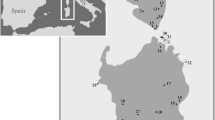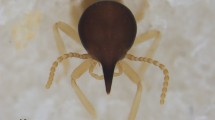Abstract
The genus Tripterygion (Risso 1826) is restricted to the eastern Atlantic and the Mediterranean, and comprises only three species. T. melanuros and T. tripteronotus are essentially endemic to the Mediterranean, while Tripterygion delaisi occurs in the Atlantic and in the Mediterranean. Two subspecies of T. delaisi have been described (T. d. xanthosoma in the Mediterranean and T. d. delaisi in the Atlantic). Several scenarios have been proposed for the evolution of T. delaisi subspecies, but so far its subspeciation process is not clear. In this study we present a population survey of T. delaisi including specimens from the two recognized subspecies. We combined a phylogeographic approach with estimates of the direction of migration (between the Atlantic and the Mediterranean) and of the coalescence time of the two subspecies, using polymorphic mitochondrial and nuclear genes. The results of this study clearly support the existence of two Tripterygion delaisi clades, one in the eastern Atlantic islands and another in the Atlantic coasts of Europe and in the Mediterranean. Historical migration between the islands and Western Europe plus Mediterranean was restricted, and showed a westbound trend, with a higher number of migrants going from the Western Europe plus Mediterranean into the islands. We estimated the time of coalescence of both groups of T. delaisi to be more recent than the onset of Pleistocene glaciations (1.7 Mya). Our results are consistent with previous hypothesis that consider successive dispersal events of a Tripterygion ancestor from the western African coast colonizing the Atlantic islands and the Mediterranean, promoting the evolutionary divergence between these areas.



Similar content being viewed by others
References
Almada VC, Oliveira RF, Gonçalves EJ, Almeida AJ, Santos RS, Wirtz P (2001) Patterns of diversity of the north-eastern Atlantic blenniid fish fauna (Pisces:Blenniidae). Glob Ecol Biogeogr 10:411–422
Almada F, Almada VC, Domingues VS, Brito A, Santos RS (2005a) Molecular validation of the specific status of Parablennius sanguinolentus and Parablennius parvicornis (Pisces: Blenniidae). Sci Mar 69(4):519–523
Almada F, Almada VC, Guillemaud T, Wirtz P (2005b) Phylogenetic relationships of the north-eastern Atlantic and Mediterranean blenniids. Biol J Linn Soc 86:283–295
Aurelle D, Guillemaud T, Afonso P, Morato T, Wirtz P, Santos RS, Cancela ML (2003) Genetic study of Coris julis (Osteichtyes, Perciformes, Labridae) evolutionary history and dispersal abilities. C R Biol 326:771–785
Bargelloni L, Alarcorn JA, Alvarez MC, Penzo E, Magoulas A, Reis C, Patarnello T (2003) Discord in the family Sparidae (Teleostei): divergent phylogeographical patterns across the Atlantic-Mediterranean divide. J Evol Biol 16:1149–1158
Bargelloni L, Alarcon JA, Alvarez MC, Penzo E, Magoulas A, Palma J, Patarnello T (2005) The Atlantic–Mediterranean transition: discordant genetic patterns in two seabream species, Diplodus puntazzo (Cetti) and Diplodus sargus (L.). Mol Phyl Evol 36:523–535
Barton ED, Arístegui J, Tett P, Cantón M, García-Braun J, Hernández-León S, Nykjaer L, Almeida C, Almunia J, Ballesteros S, Basterretxea G, Escánez J, García-Weill L, Hernández-Guerra A., López-Laatzen F, Molina R, Montero MF, Navarro-Pérez E, Rodríguez J M, Lenning K van, Vélez H, Wild K (1998) The transition zone of the Canary Current upwelling region. Prog Oceanogr 41:455–504
Beerli P (2004) Migrate: documentation and program, part of Lamark. Version 2.0. Available at http://evolution.gs.washington.edu/lamarc.html
Beerli P, Felsenstein J (2001) Maximum likelihood estimation of a migration matrix and effective population sizes in n subpopulations by using a coalescent approach. Proc Natl Acad Sci USA 98:4563–4568
Borsa P, Blanquer A, Berrebi P (1997) Genetic structure of the flounders Platichthys flesus and P. Stellatus at different geographic scales. Mar Biol 129:233–246
Briggs JC (1974) Marine Zoogeography. Mcgraw-Hill, London
Briggs JC (1996) Global Biogeography Vol. 14. Developments in Paleontology and Stratigraphy. Elsevier, Amsterdam
Brownell CL (1978) Sur quelques collections de poissons littoraux de l’Atlantique Marocain. Bull Inst Pêches Marit 23:111–133
Carreras-Carbonlell J, MacPherson E, Pascual M (2005) Rapid radiation and cryptic speciation in mediterranean tripleWn blennies (Pisces: Tripterygiidae) combining multiple genes. Mol Phyl Evol 37:751–761
Chikhi L, Agnese JF, Bonhomme F (1997) Strong differences of mitochondrial DNA between Mediterranean Sea and eastern Atlantic populations of Sardinella aurita. Comptes Rendus de l’ Academie des Sciences Serie III Sci Vie 320:289–297
Chow S, Hazama K (1998). Universal PCR primers for S7 ribosomal protein gene introns in fish. Mol Ecol 7:1247–1263
Costagliola D, Robertson DR, Guidetti P, Stefanni S, Wirtz P, Heiser JB, Bernardi G (2004) Evolution of coral reef fish Thalassoma pavo spp. (Labridae). 2. Evolution of the eastern Atlantic species. Mar Biol 144:377–383
Dias JA, Rodrigues A, Magalhães F (1997) Evolução da linha de costa em Portugal, desde o último máximo glaciário até à actualidade: síntese dos conhecimentos. Estudos do Quaternário 1:53–66
Domingues VS, Bucciarelli G, Almada VC, Bernardi G (2005) Historical colonization and demography of the Mediterranean damselfish, Chromis chromis. Mol Ecol 14:4051– 4063
Duran S, Pascual M, Turon X (2004) Low levels of genetic variation in mtDNA sequences over the western Mediterranean and Atlantic range of the sponge Crambe crambe (Poecilosclerida). Mar Biol 144:31–35
Edwards SV, Beerli P (2000) Gene divergence, population divergence, and the variance in coalescence time in phylogeographic studies. Evolution 54:1839–1854
Excoffier L, Smouse PE, Quattro JM (1997) Analysis of molecular variance inferred from metric distances among DNA haplotypes: application to human mitochondrial DNA restriction data. Genetics 131:479–491
Falcón JM, Brito A, González G (2002) Peces de la laguna de Khnifiss (Sáhara, NW África) y de los sectores costeros próximos. Re Acad Canar Cienc 14(3–4):139–152
Felsenstein J (1985) Confidence limits on phylogenies: an approach using the bootstrap. Evolution 39:783–791
Geertjes GJ, Kamping A,van Delden W, Videler JJ (2001) Genetic relationships among one non-endemic and two endemic mediterranen Triplefin Blennies (Pisces, Blennioidei). Mar Ecol 22:255–265
Jonge J, Videler JJ (1989) Differences between the reproductive biologies of Tripterygion tripteronotus and T. delaisi (Pisces, Perciformes, Tripterygiidae) the adaptive significance of an alternative mating strategy and a red instead of a yellow nuptial colour. Mar Biol 100:431–437
Kotoulas G, Magoulas A, Tsimenides N, Zurros E (1995) Marked mitochondrial differences between Mediterranean and Atlantic populations of the swordfish Xiphias gladius. Mol Ecol 4:473–481
Kuhner MK, Yamato J, Felsenstein J (1998) Maximum likelihood estimation of population growth rates based on the coalescent. Genetics 149:429–434
Lee WJ, Conroy J, Howell WH, Kocher TD (1995) Structure and evolution of teleost mitochondrial control regions. J Mol Evol 41:54–66
Miller PJ (1984) The gobiid fishes of temperate Macaronesia (eastern Atlantic). J Zool Lond 204:363–412
Naciri M, Lemaire C, Borsa P, Bonhomme F (1999) Genetic study of the Atlantic/Mediterranean transition in Sea bass (Dicentrarchus labrax). J Hered 90:591–596
Nei M, Kumar S (2000) Molecular Evolution and Phylogenetics. Oxford University Press, Oxford
Pérez-Losada M, Guerra A, Sanjuan A (1999) Allozyme differentiation in the cuttlefish Sepia officinalis (Mollusca: Cephalopoda) from the NE Atlantic and Mediterranean. Heredity 83:280–289
Pérez-Losada M, Guerra A, Carvalho GR, Sanjuan A, Shaw PW (2002) Extensive population subdivision of the cuttlefish Sepia officialis (Mollusca: Cephalopoda) around the Iberian Peninsula indicated by microsatellite DNA variation. Heredity 89:417–424
Quesada H, Beynon CM, Skibinski DOF (1995) A mitochondrial DNA discontinuity in the mussel Mytilus galloprovincialis Lmk: Pleistocene vicariance biogeography and secondary intergradation. Mol Biol Evol 12:521–524
Raventós N, Macpherson E (2001) Planktonic larval duration and settlement marks on the otoliths of Mediterranean littoral fishes. Mar Biol 138:1115–1120
Rice WR (1989) Analyzing tables of statistical tests. Evolution 43:223–225
Riginos C, Victor BC (2001) Larval spatial distributions and other early life-history characteristics predict genetic differentiation in eastern Pacific blennioid fishes. Proc R Soc Lond B 268:1931–1936
Rodríguez JM, Hernández-León S, Barton ED (1999) Mesoscale distribution of fish larvae in relation to an upwelling filament off Northwest Africa. Deep-Sea Res I 46:1969–1984
Sambrook J, Fritsch EF, Maniatis T (1989) Molecular Cloning a Laboratory Manual. 2nd edn. Cold Spring Harbor Laboratory Press, New York
Santos RS, Hawkins S, Monteiro LR, Alves M, Isidro EJ (1995) Marine research, resources and conservation in the Azores. Aquat Conserv Mar Freshw Ecosyst 5:311–354
Schneider S, Roessli D, Excoffier L (2000) ARLEQUIN, Version 2.000: A Software for Population Genetics Data Analysis. University of Geneva, Switzerland
Stamatis C, Trianfylidis A, Moutou KA, Mamuris Z (2004) Mitochondrial DNA variation in Northeast Atlantic and Mediterranean populations of Norway lobster, Nephrops norvegicus. Mol Ecol 13:1377–1390
Stramma L (1984) Geostrophic transport in the warm water sphere of the eastern subtropical North Atlantic. J Mar Res 42:537–558
Swofford DL (1998) PAUP: phylogenetic analysis using parsimony and other methods. Sinauer Associates, Sunderland
Wares JP, Cunningham CW (2001) Phylogeography and historical ecology of the north Atlantic intertidal. Evolution 55:2455–2469
Wirtz P (1978) The behaviour of the Mediterranean Tripterygion species (Pisces, Blennioidei). Zeit Tierpsychol 48:142–174
Wirtz P (1980) A revision of the eastern Atlantic Tripterygiidae (Pisces, Blennioidei) and notes on some westafrican blennioid fish. Cybium 11:83–101
Wirtz P (1990) Tripterygiidae. In: Quero JC, Hureau JC, Karrer C, Post A, Saldanha A (eds) Check-list of the fishes of the eastern tropical Atlantic (CLOFETA). UNESCO, Paris, pp 916–917
Zander CD (1973) Evolution of blennioidei in the Mediterranean sea. Rev Trav Inst Pêches Marit 37:215–221
Zander CD (1980) Zoogeography and speciation of Mediterranean blennioids. Journées de Etudes Systématiques et Biogéographiques de Mediterraneen, CIESM, Cagliari,13–38
Zander CD (1986) Blenniidae. In: Whitehead PM, Bauchot L, Hureau, Nielsen J and Tortonese E (eds) Fishes of the North-Eastern Atlantic and the Mediterranean. Vol. 3, UNESCO, Paris, pp 1096–1112
Zander CD, Heymer A (1970) Tripterygion tripteronotus (Risso, 1810) und Tripterygion xaenthosoma n. sp. Eine Okologische Speziation (Pisces, Teleostei). Vie Milieu 21:363–394
Zardoya R, Castilho R, Grande C, Favre-Krey L, Caetano S, Marcato S, Krey G, Patarnello T. (2004) Differential population structuring of two closely related fish species, the mackerel (Scomber scombrus) and the chub mackerel (Scomber japonicus), in the Mediterranean Sea. Mol Ecol 13:1785–1798
Acknowledgments
We would like to thank P. Wirtz and R. Hanel for Triprerygion samples from different localities. We also thank P. Wirtz for his helpful comments. This research was partly founded by a PhD grant SFRH/BD/13069/2003, from the Portuguese Foundation for Science and Technology (VSD), and by the David and Lucille Packard Foundation’s PISCO program. ISPA and IMAR-DOP/UAz are funded by FCT through a pluri-annual and programmatic funding schemes (FEDER).
Author information
Authors and Affiliations
Corresponding author
Additional information
Communicated by R. Cattaneo-Vietti, Genova
Rights and permissions
About this article
Cite this article
Domingues, V.S., Almada, V.C., Santos, R.S. et al. Phylogeography and evolution of the triplefin Tripterygion delaisi (Pisces, Blennioidei). Mar Biol 150, 509–519 (2007). https://doi.org/10.1007/s00227-006-0367-4
Received:
Accepted:
Published:
Issue Date:
DOI: https://doi.org/10.1007/s00227-006-0367-4




